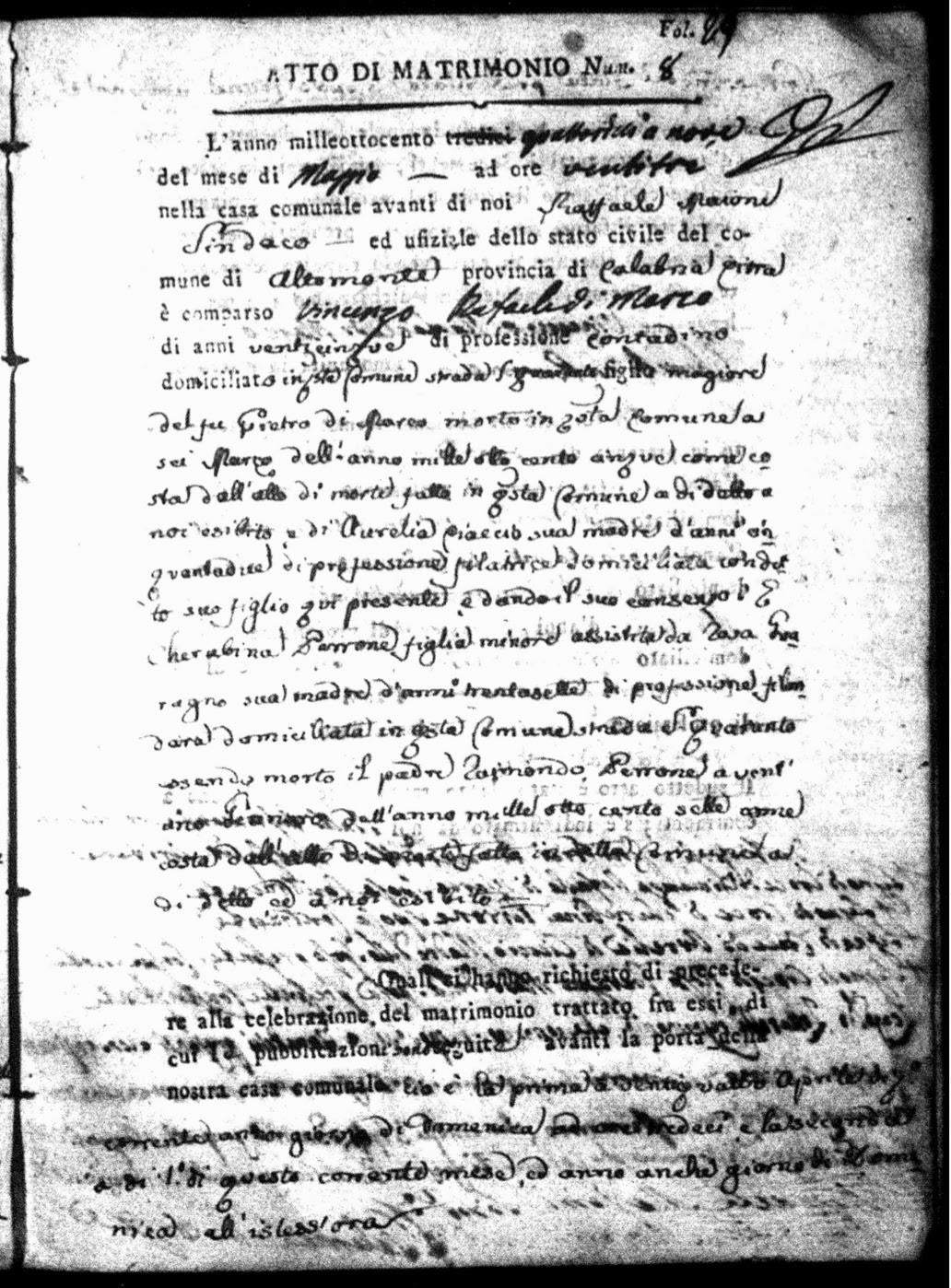I find it interesting when a civil record provides more information than was required by law. Below is a translated abstraction of the marriage record of Vincenzo Rafaele di Marco and Cherubina Perrone. The abstraction includes all genealogically useful information from the document. The unusual portions and a clue that might lead to additional information [including my explanations] have been highlighted in purple.
Marriage Record of Vincenzo
Rafaele di Marco and Cherubina Perrone
This couple appeared in the
Altomonte town hall on 9 May 1814 at 11:00 p.m. to be married. The groom was Vincenzo Rafaele di Marco, of legal age, age twenty-five
[born about 1789], a peasant farmer, and resident of this town on San Quaranto
[?] Avenue. He was the son of the deceased Pietro [di Marco], who died in this
town on 6 March 1805 but whose death record does not exist, as well as the
living Aurelia Ciaccio, age forty-two [born about 1772], a seamstress, and
resident of Altomonte in the household of her son, the groom. They note that
his mother gave consent for the marriage [even though this wasn’t necessary
because he was of legal age.]
The bride was Cherubina Perrone, a
minor [no age given]. Her parents were the living Rosa Guaragno, thirty-seven
years old [born about 1777], a weaver, and resident of this town on San
Quaranto Avenue as well as the deceased Raimondo Perrone, who died in this town
on 21 January 1807 but whose death record does not exist.
The first marriage bann was posted
on Sunday, 24 April 1814 and the second bann on Sunday, 13 [?, ink bleed-through]
May 1814. There were no oppositions to the marriage.
The witnesses were: Leopoldo
Lattarchi, age thirty-four, a priest, and resident of this town on Pequaria [?]
Avenue; Giuseppe Adamo, age forty-four, a mason, and resident of this town on
[illegible] Avenue; Vincenzo Maione, age forty-seven, an Archpriest, and a
resident of this town on Pequaria [?] Avenue; and Carmelo Guaragno, age thirty,
a municipal employee, and a resident of Morano [perhaps Morano Calabro] on La
Piazza Avenue.
The bride, groom, and their mothers
were present but could not write. They each made their mark at the bottom of
the document.[1]
COMMENTS: Interestingly, this
document was not in the form of a marriage promise, as is usually seen in this
part of Italy prior to 1865.
They apparently looked for the death records of
both fathers, as they would do for any marriage, but neither death record was
found. It is unusual for them to include the exact dates of death for each father within the actual marriage document. Normally, they would just be marked as deceased and their death records included in the marriage supplements. They may have given the information within the marriage document because their death records could not be found.
There was a lot of ink
bleed-through from the other side of this document that made the bottom section
of page 1 difficult to read.
The last witness may be a
relative of the bride’s mother, as their surnames are the same. It is unlikely
that this man worked for the town of Altomonte because Morano Calabro is a
little too far away for someone to travel to work on a daily basis, especially
in 1814 [see below]. It is likely he was a town employee in Morano Calabro. This may be a
clue as to the origins of the Guaragno family.
[1]
Altomonte, Cosenza
Province, Italy, “Registro di Atto di Matrimonio [Register of Acts of
Marriage], 1814,” record 8, page 29 [?], marriage record of Vincenzo Rafaele di
Marco and Cherubina Perrone; Family History Library microfilm #1,329,794.



1 comment:
Melanie, this is a great example of how to extract lots of information from a civil record, and I'm going to post it to a couple Italian genealogy groups on Facebook for folks who are starting out.
You comment that it's usually the marriage promise (atto di solenne promesso) that appears in this part of Italy, not the atto di matrimonio. In Basilicata, the atti di solenne promesso appears in the processetti (in the Family History Library, these are on the microfilms listed by town), and the atti di matrimonio stand alone in the films of records from the provincial archives in Matera and Potenza. Both include the list of allegati.
Post a Comment